| Irish Forums Message Discussion :: Blood of the Irish |
   | Irish Forums :: The Irish Message
Forums About Ireland and the Irish Community, For the Irish home and Abroad. Forums include- Irish Music, Irish History, The Irish Diaspora, Irish Culture, Irish Sports, Astrology, Mystic, Irish Ancestry, Genealogy, Irish Travel, Irish Reunited and Craic
|  
|
|
|
| Irish
Author |
Blood of the Irish Sceala Irish Craic Forum Irish Message |
|
HennessyTom
Irish Forums Member
Location: Dublin
|
| Sceala Irish Craic Forum Discussion:
Blood of the Irish
|
|
|
TV tonight.
New series from RTE examines the blood of the Irish.
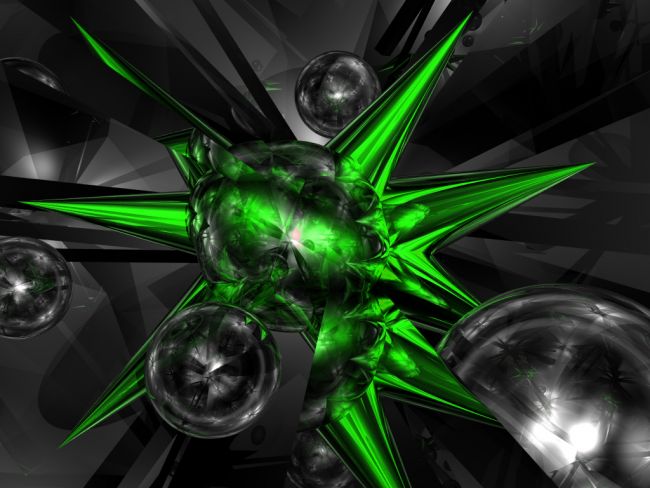
Was Ireland first settled only 9,000 years ago by a mysterious race of people who travelled by land and sea up the coast from northern Spain and southern France. Who were these people, how did they travel and why does their legacy prevail to this day? Were they our first ancestors? The very latest genetic research is begining to provide the answers.
A two-part documentary series that seeks the truth about the Irish.
Broadcaster Diarmuid Gavin travels to the heart of Africa and beyond in a quest to find the very origins of the Irish people. Who are the Irish and whose blood flows in our veins?
A landmark series for RTE One, Blood of the Irish explores the most fundamental questions about the Irish population, who were the first people to settle here and where did they come from?
The Background
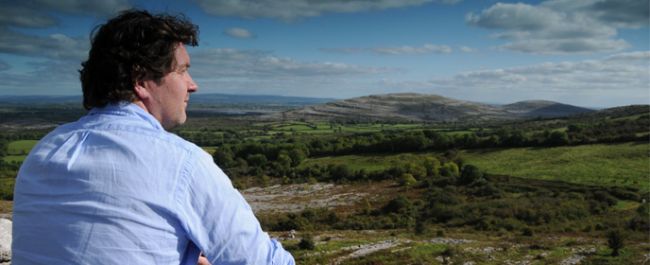
Revelations
Blood of the Irish is a spectacular voyage of discovery. Diarmuid Gavin travels to the birthplace of humankind in Africa and unveils extraordinary recent findings about our identity. The latest research on our DNA shows that, contrary to popular opinion, the Irish are not descended from the Celts. In fact, our true genetic origins date from the stone-age, many thousands of years before the Celtic tribes emerged in Europe.
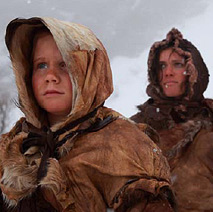
The Family
Featuring stunning high definition photography of some of the most remarkable early human locations on Earth, Blood of the Irish focuses on one symbolic family, a man, woman and a child who undertake a 55 thousand year journey out of Africa, crossing salt deserts, mountain ranges and glaciers before making the last leg to Ireland. As Diarmuid shadows our ancestral family - dressed authentically by some of the world's leading experts in such dramatic reconstructions - he observes from a distance, telling their story.
The Journey
En route, Diarmuid explores the key locations in humankind's journey from Africa to Ireland. Starting with the stunning vistas of Kenya's Eastern Rift Valley where modern humans evolved around 200,000 years ago, Diarmuid also visits the exquisite cave paintings of El Castillo in Cantabria, Spain, and comes tantalisingly close to home in Britain when he tracks down human traces going back more than 700,000 years; he asks why is it another 690,000 years before the first evidence appears of people in Ireland?
Ireland
To unravel the mystery of our beginnings, Blood of the Irish visits some of the most exciting archaeological sites in Ireland and follows the country's leading researchers as they explore remote and inaccessable caves searching for the faintest traces of the earliest Irish people. The series reveals the very latest research on some hoary old chestnuts. How much Celtic blood really flows in us? Are the dark-eyed, dark-skinned inhabitants of the West of Ireland truly a legacy of roving Spanish Armadas and wine merchants?
Programme One
Ireland was first settled around 9,000 years ago by a mysterious race of people who travelled by land and sea up the coast from northern Spain and southern France. Who were these people, how did they travel and why does their legacy prevail to this day? Were they our ancestors? The very latest genetic research is begining to provide the answers.
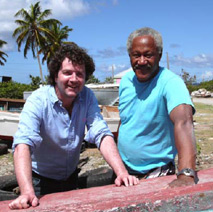
In Programme One, Prof. David McConnell of Trinity College Dublin explains how DNA - our genetic code - contains a vast storehouse of information about who we are and where we have come from. Unravelling our DNA is like opening an atlas and tracing our lineage back across the continents. Diarmuid Gavin picks up the story in the Eastern Rift Valley Kenya where, around 65,000 years ago, our ancestral family began a migration that over millennia would bring then to Ireland. He meets the palaeontologist Louise Leakey, daughter of Richard Leakey, the world expert in human origins, as she gently uncovers the fractured skull of an early hominid. Louise explains that the archaeological findings and the genetic evidence now point to an African origin for our species around 200,000 years ago. Then around 65,000 years ago humans began to expand out of Africa to eventually colonise the entire Globe.
Meanwhile in a cave in Northern Spain, Diarmuid discovers that during the last Ice Age, around 20,000 years ago, a few small pockets of Europe still remained habitable. The beautiful wall paintings of animals in El Castillo cave in Cantabria are clear evidence that humans thrived here over many thousands of years. Is it possible that the ancestors of the Irish were among them?
There are old myths and stories which link Ireland and Spain. In the Royal Irish Academy in Dublin there is a rare manuscript from the middle ages which tells the story of the invasion of Ireland by the Milesians, who were sea-warriors from Spain and reputed to have established the ancient clans of Ireland. Diarmuid travels to the fishing port of Bermeo in the Basque region of Northern Spain and is surprised at how similar the local people are to the Irish. But how close are the genetic links between the Basques and the Irish?
Scientists have been collecting and analysing DNA samples from people all over Europe to build a map of genetic diversity across the continent. In Trinity College Dublin, Prof. Dan Bradley and his team are using Irish Dna to explore our ancient origins and connections with other peoples. As part of this research, they have discovered that 20% of men in the north-west of Ireland are descended from just one man, Niall of the Nine Hostages, the well known high king from the 4th century who brought St Patrick as a slave to Ireland.
Diarmuid Gavin travels to the West of Ireland where he meets local people who believe that their dark features are a result of a Spanish influence along the coastline since the time of the Armada. To find out if this is true, Diarmuid collects saliva samples containing Dna for analysis. The results will be revealed in Programme Two of Blood of the Irish and will prove to be an vital clue in the search for the true origins of the Irish.
Can we extract and analyse the DNA from this ancient body? Charting real science in action, in programme two Blood of the Irish will reach some stunning conclusions.
Programme Two
Diarmuid Gavin picks up the trail of the first Irish at La Mer de Glace, one of Europe's largest glaciers, near Chamonix, France. Today the slopes are packed with skiers and people enjoying all kinds of adventure sports. But 20,000 years ago it was a different story, back then, ice was the enemy. In Programme Two, Diarmuid examines the way in which the ice-age affected the destiny of our species and also the eventual settlement of Ireland. Twenty thousand years ago as the ice tightened its grip, most of the continent of Europe - but not Ireland - had been penetrated by small groups of nomadic people.
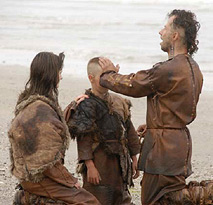
They had ventured north on an epic journey out of Africa that had taken millennia. But the ice forced people south and places like Northern Spain became a vital refuge for our species. Then, around 12,000 years ago people ventured north again and, as we now know, the ancestors of the Irish were among them. But how did they get to Ireland? Was it overland or by sea?
At Carlingford Lough, Diarmuid takes to the sea in a 20ft currach made of leather skins and hazel wood to test the theory that the first Irish arrived here by boat. Using only materials and techniques that were available in the stone-age, boat builder Cliadhbh O Gibne shows how people could easily have crossed the seas in stages to Ireland. Prof. Peter Woodman has spent a lifetime searching for the first evidence of humans in Ireland. Based on recent discoveries from all over Ireland, Peter says that our stone-age ancestors were far more successful and more numerous than previously believed. He is now convinced that the genetic make-up of the Irish population was well established in the stone-age and that these people were just like us. They are our ancestors.
In a dimly lit cave deep under the limestone crust of the Burren in Co Clare, archaeologist Dr Marian Dowd carefullly removes the bones of a 3 year old child whose remains have been undisturbed since the bronze age. Small pieces of the 3,500 year old bone are gingerly placed in airtight containers and sent to Germany for analysis at one of the world's leading laboratories in the detection and analysis of ancient DNA. If successful this will be the oldest human DNA ever obtained in Ireland. What will it reveal about our ancestry?
In Germany, the extraction of ancient Dna from the 3,500 year old child's bone proves a great success and for the first time scientists have specific genetic information about an Irish person who lived in pre-historic times. As a postscript to Blood of the Irish, Diarmuid Gavin goes back to the Burren and collects more Dna samples to see if it is possible to find people alive today who are related to the child from the bronze age.
|
|
|
|
|
|
|
|
|
|













